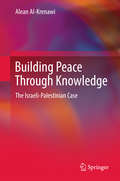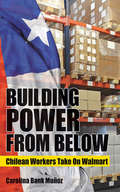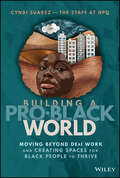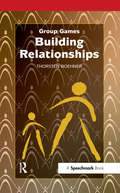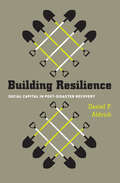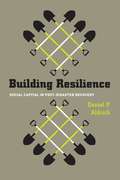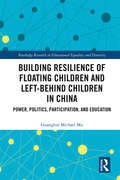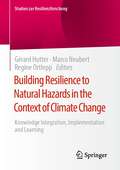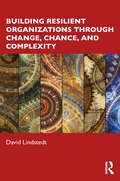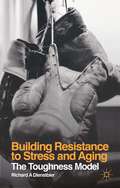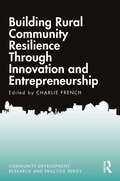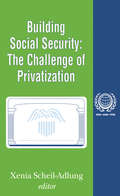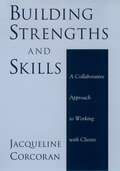- Table View
- List View
Building Peace Through Knowledge: The Israeli-Palestinian Case
by Alean Al-KrenawiThis groundbreaking volume documents a comprehensive peacebuilding initiative in addressing the Israeli-Palestinian conflict and reviews the broad theoretical base underlying these efforts. Theory chapters discuss intrinsic peace-related concepts, including the nature of conflict, elements of individual and group identity, the long-term psychological effects of prolonged political hostilities, and the mechanisms of reconciliation and inclusiveness. Central to the coverage is the ambitious Building Peace through Knowledge Project, a four-year multidisciplinary program featuring a diverse palette of professional and community interventions to reduce the occurrence and trauma of political violence. The author reveals powerful insights connecting knowledge to peacebuilding by analyzing: · The relationships between attitudes and ideology in intergroup conflict. · The psychosocial impact of political violence among Israelis and Palestinians. · The literature on people-to-people interventions (P2Ps) in conflict reduction. · The roles of forgiveness, reconciliation, and fairness in conflict resolution. · The methodology and findings of the Building Peace through Knowledge Project. · The potential of knowledge-based interventions in building sustainable peace in other regions. Practitioners, mental health professionals, and scholars with interests in multicultural mental health, cross-cultural psychology, political violence, and peace education will look to Building Peace through Knowledge as an ideabook, a mission statement, and a road map toward a more stable world.
Building Positive Momentum for Positive Behavior in Young Children: Strategies for Success in School and Beyond
by Lisa RogersLearn how to use positive momentum to address common behavioral issues in the classroom and beyond. The strategies in this book show how to get long-term results, with illustrative case examples and downloadable resources for tracking progress. It also offers advice for working with children with special needs.
Building Power from Below: Chilean Workers Take On Walmart
by Carolina Bank MuñozA story that involves as its main players "workers" and "Walmart" does not usually have a happy ending for labor, so the counternarrative offered by Building Power from Below is must reading for activists and union personnel as well as scholars. In 2008 Walmart acquired a controlling share in a large supermarket chain in Santiago, Chile. As part of the deal Walmart had to accept the unions that were already in place. Since then, Chilean retail and warehouse workers have done something that has seemed impossible for labor in the United States: they have organized even more successful unions and negotiated unprecedented contracts with Walmart.In Building Power from Below, Carolina Bank Muñoz attributes Chilean workers’ success in challenging the world’s largest corporation to their organizations’ commitment to union democracy and building strategic capacity. Chilean workers have spent years building grassroots organizations committed to principles of union democracy. Retail workers’ unions have less structural power, but have significant associational and symbolic power. Their most notable successes have been in fighting for respect and dignity on the job. Warehouse workers by contrast have substantial structural power and have achieved significant economic gains. While the model in Chile cannot necessarily be reproduced in different countries, we can gain insights from the Chilean workers’ approaches, tactics, and strategies.
Building A Pro-Black World: Moving Beyond DE&I Work and Creating Spaces for Black People to Thrive
by Nonprofit QuarterlyLearn to create a nonprofit organization and society in which Black people can thrive In Building A Pro-Black World: A Guide To Creating True Equity in The Workplace and In Life, a team of dedicated nonprofit leaders delivers a timely roadmap to building pro-Black nonprofit organizations. Refreshingly moving the conversation beyond stale DEI cliches, editors Cyndi Suarez and the NPQ staff have included works from leading racial justice voices that show you how to create an environment—and society—in which Black people can thrive. You’ll also learn how building such a world will benefit all of society, from the most marginalized to the least. The book explains how to shift from simply critiquing white supremacist culture and calling out anti-Blackness to actively designing for pro-Blackness. It offers you: Incisive and engaging work from leading voices in racial justice, Cyndi Suarez, Dax-Devlon Ross, Liz Derias, Kad Smith, and Isabelle Moses Explorations of topics ranging from restorative leadership strategies for staff wellbeing to Black politics and policymaking Discussions of new language for pro-Black social change, racial equity in healthcare and health communications, and antiracist succession planning A can’t-miss resource for civil society and nonprofit leaders, including directors, executives, grant makers, philanthropic donors, and social movement leaders, Building Pro-Black World will also benefit communicators, organizers, and consultants who work with nonprofit organizations.
Building A Pro-Black World: Moving Beyond DE&I Work and Creating Spaces for Black People to Thrive
by Nonprofit QuarterlyLearn to create a nonprofit organization and society in which Black people can thrive In Building A Pro-Black World: A Guide To Creating True Equity in The Workplace and In Life, a team of dedicated nonprofit leaders delivers a timely roadmap to building pro-Black nonprofit organizations. Refreshingly moving the conversation beyond stale DEI cliches, editors Cyndi Suarez and the NPQ staff have included works from leading racial justice voices that show you how to create an environment—and society—in which Black people can thrive. You’ll also learn how building such a world will benefit all of society, from the most marginalized to the least. The book explains how to shift from simply critiquing white supremacist culture and calling out anti-Blackness to actively designing for pro-Blackness. It offers you: Incisive and engaging work from leading voices in racial justice, Cyndi Suarez, Dax-Devlon Ross, Liz Derias, Kad Smith, and Isabelle Moses Explorations of topics ranging from restorative leadership strategies for staff wellbeing to Black politics and policymaking Discussions of new language for pro-Black social change, racial equity in healthcare and health communications, and antiracist succession planning A can’t-miss resource for civil society and nonprofit leaders, including directors, executives, grant makers, philanthropic donors, and social movement leaders, Building Pro-Black World will also benefit communicators, organizers, and consultants who work with nonprofit organizations.
Building Relationships (Group Games)
by Thorsten Boehner Lilo SeelosGroup Games: Building Relationships Thorsten Boehner - A comprehensive collection of 140 games and activities to foster personal development; improve social communication skills; and strengthen group dynamics. Full of practical and creative ideas that can be implemented with minimal preparation and equipment. 140 games and activities to foster personal development; improve social communication skills; and strengthen group dynamics. Full of practical and creative ideas that can be implemented with minimal preparation and equipment. Suitable for all ages, the games will increase self- and other-awareness; improve recognition of one's own limits as well as awareness of the limits of others; encourage better teamwork skills; and increase flexibility as participants gain new experiences in a playful and safe environment. Includes: Group gel activities; Warm-up activities; Exercises for building trust and awareness; Imagination and improvisation; Closing exercises; Special exercises and tips for amateur dramatics lovers.
Building Relationships (Group Games)
by Thorsten Boehner Lilo SeelosGroup Games: Building Relationships Thorsten Boehner - A comprehensive collection of 140 games and activities to foster personal development; improve social communication skills; and strengthen group dynamics. Full of practical and creative ideas that can be implemented with minimal preparation and equipment. 140 games and activities to foster personal development; improve social communication skills; and strengthen group dynamics. Full of practical and creative ideas that can be implemented with minimal preparation and equipment. Suitable for all ages, the games will increase self- and other-awareness; improve recognition of one's own limits as well as awareness of the limits of others; encourage better teamwork skills; and increase flexibility as participants gain new experiences in a playful and safe environment. Includes: Group gel activities; Warm-up activities; Exercises for building trust and awareness; Imagination and improvisation; Closing exercises; Special exercises and tips for amateur dramatics lovers.
Building Resilience: Social Capital in Post-Disaster Recovery
by Daniel P. AldrichEach year, natural disasters threaten the strength and stability of communities worldwide. Yet responses to the challenges of recovery vary greatly and in ways that aren’t explained by the magnitude of the catastrophe or the amount of aid provided by national governments or the international community. The difference between resilience and disrepair, as Daniel P. Aldrich shows, lies in the depth of communities’ social capital. Building Resilience highlights the critical role of social capital in the ability of a community to withstand disaster and rebuild both the infrastructure and the ties that are at the foundation of any community. Aldrich examines the post-disaster responses of four distinct communities—Tokyo following the 1923 earthquake, Kobe after the 1995 earthquake, Tamil Nadu after the 2004 Indian Ocean Tsunami, and New Orleans post-Katrina—and finds that those with robust social networks were better able to coordinate recovery. In addition to quickly disseminating information and financial and physical assistance, communities with an abundance of social capital were able to minimize the migration of people and valuable resources out of the area. With governments increasingly overstretched and natural disasters likely to increase in frequency and intensity, a thorough understanding of what contributes to efficient reconstruction is more important than ever. Building Resilience underscores a critical component of an effective response.
Building Resilience: Social Capital in Post-Disaster Recovery
by Daniel P. AldrichEach year, natural disasters threaten the strength and stability of communities worldwide. Yet responses to the challenges of recovery vary greatly and in ways that aren’t explained by the magnitude of the catastrophe or the amount of aid provided by national governments or the international community. The difference between resilience and disrepair, as Daniel P. Aldrich shows, lies in the depth of communities’ social capital. Building Resilience highlights the critical role of social capital in the ability of a community to withstand disaster and rebuild both the infrastructure and the ties that are at the foundation of any community. Aldrich examines the post-disaster responses of four distinct communities—Tokyo following the 1923 earthquake, Kobe after the 1995 earthquake, Tamil Nadu after the 2004 Indian Ocean Tsunami, and New Orleans post-Katrina—and finds that those with robust social networks were better able to coordinate recovery. In addition to quickly disseminating information and financial and physical assistance, communities with an abundance of social capital were able to minimize the migration of people and valuable resources out of the area. With governments increasingly overstretched and natural disasters likely to increase in frequency and intensity, a thorough understanding of what contributes to efficient reconstruction is more important than ever. Building Resilience underscores a critical component of an effective response.
Building Resilience: Social Capital in Post-Disaster Recovery
by Daniel P. AldrichEach year, natural disasters threaten the strength and stability of communities worldwide. Yet responses to the challenges of recovery vary greatly and in ways that aren’t explained by the magnitude of the catastrophe or the amount of aid provided by national governments or the international community. The difference between resilience and disrepair, as Daniel P. Aldrich shows, lies in the depth of communities’ social capital. Building Resilience highlights the critical role of social capital in the ability of a community to withstand disaster and rebuild both the infrastructure and the ties that are at the foundation of any community. Aldrich examines the post-disaster responses of four distinct communities—Tokyo following the 1923 earthquake, Kobe after the 1995 earthquake, Tamil Nadu after the 2004 Indian Ocean Tsunami, and New Orleans post-Katrina—and finds that those with robust social networks were better able to coordinate recovery. In addition to quickly disseminating information and financial and physical assistance, communities with an abundance of social capital were able to minimize the migration of people and valuable resources out of the area. With governments increasingly overstretched and natural disasters likely to increase in frequency and intensity, a thorough understanding of what contributes to efficient reconstruction is more important than ever. Building Resilience underscores a critical component of an effective response.
Building Resilience: Social Capital in Post-Disaster Recovery
by Daniel P. AldrichEach year, natural disasters threaten the strength and stability of communities worldwide. Yet responses to the challenges of recovery vary greatly and in ways that aren’t explained by the magnitude of the catastrophe or the amount of aid provided by national governments or the international community. The difference between resilience and disrepair, as Daniel P. Aldrich shows, lies in the depth of communities’ social capital. Building Resilience highlights the critical role of social capital in the ability of a community to withstand disaster and rebuild both the infrastructure and the ties that are at the foundation of any community. Aldrich examines the post-disaster responses of four distinct communities—Tokyo following the 1923 earthquake, Kobe after the 1995 earthquake, Tamil Nadu after the 2004 Indian Ocean Tsunami, and New Orleans post-Katrina—and finds that those with robust social networks were better able to coordinate recovery. In addition to quickly disseminating information and financial and physical assistance, communities with an abundance of social capital were able to minimize the migration of people and valuable resources out of the area. With governments increasingly overstretched and natural disasters likely to increase in frequency and intensity, a thorough understanding of what contributes to efficient reconstruction is more important than ever. Building Resilience underscores a critical component of an effective response.
Building Resilience: Social Capital in Post-Disaster Recovery
by Daniel P. AldrichEach year, natural disasters threaten the strength and stability of communities worldwide. Yet responses to the challenges of recovery vary greatly and in ways that aren’t explained by the magnitude of the catastrophe or the amount of aid provided by national governments or the international community. The difference between resilience and disrepair, as Daniel P. Aldrich shows, lies in the depth of communities’ social capital. Building Resilience highlights the critical role of social capital in the ability of a community to withstand disaster and rebuild both the infrastructure and the ties that are at the foundation of any community. Aldrich examines the post-disaster responses of four distinct communities—Tokyo following the 1923 earthquake, Kobe after the 1995 earthquake, Tamil Nadu after the 2004 Indian Ocean Tsunami, and New Orleans post-Katrina—and finds that those with robust social networks were better able to coordinate recovery. In addition to quickly disseminating information and financial and physical assistance, communities with an abundance of social capital were able to minimize the migration of people and valuable resources out of the area. With governments increasingly overstretched and natural disasters likely to increase in frequency and intensity, a thorough understanding of what contributes to efficient reconstruction is more important than ever. Building Resilience underscores a critical component of an effective response.
Building Resilience: Social Capital in Post-Disaster Recovery
by Daniel P. AldrichEach year, natural disasters threaten the strength and stability of communities worldwide. Yet responses to the challenges of recovery vary greatly and in ways that aren’t explained by the magnitude of the catastrophe or the amount of aid provided by national governments or the international community. The difference between resilience and disrepair, as Daniel P. Aldrich shows, lies in the depth of communities’ social capital. Building Resilience highlights the critical role of social capital in the ability of a community to withstand disaster and rebuild both the infrastructure and the ties that are at the foundation of any community. Aldrich examines the post-disaster responses of four distinct communities—Tokyo following the 1923 earthquake, Kobe after the 1995 earthquake, Tamil Nadu after the 2004 Indian Ocean Tsunami, and New Orleans post-Katrina—and finds that those with robust social networks were better able to coordinate recovery. In addition to quickly disseminating information and financial and physical assistance, communities with an abundance of social capital were able to minimize the migration of people and valuable resources out of the area. With governments increasingly overstretched and natural disasters likely to increase in frequency and intensity, a thorough understanding of what contributes to efficient reconstruction is more important than ever. Building Resilience underscores a critical component of an effective response.
Building Resilience: Social Capital in Post-Disaster Recovery
by Daniel P. AldrichEach year, natural disasters threaten the strength and stability of communities worldwide. Yet responses to the challenges of recovery vary greatly and in ways that aren’t explained by the magnitude of the catastrophe or the amount of aid provided by national governments or the international community. The difference between resilience and disrepair, as Daniel P. Aldrich shows, lies in the depth of communities’ social capital. Building Resilience highlights the critical role of social capital in the ability of a community to withstand disaster and rebuild both the infrastructure and the ties that are at the foundation of any community. Aldrich examines the post-disaster responses of four distinct communities—Tokyo following the 1923 earthquake, Kobe after the 1995 earthquake, Tamil Nadu after the 2004 Indian Ocean Tsunami, and New Orleans post-Katrina—and finds that those with robust social networks were better able to coordinate recovery. In addition to quickly disseminating information and financial and physical assistance, communities with an abundance of social capital were able to minimize the migration of people and valuable resources out of the area. With governments increasingly overstretched and natural disasters likely to increase in frequency and intensity, a thorough understanding of what contributes to efficient reconstruction is more important than ever. Building Resilience underscores a critical component of an effective response.
Building Resilience of Floating Children and Left-Behind Children in China: Power, Politics, Participation, and Education (Routledge Research in Educational Equality and Diversity)
by Guanglun Michael MuThe past two decades have seen exponential growth of urbanisation and migration in China. Emerging from this growth is a population of floating and left-behind children which is estimated to be approaching 100 million. Due to their increasing risks of undesirable educational and social, as well as health and psychological, outcomes, there is a great urgency to help floating children and left-behind children beat the odds. This book offers an analysis of how oscillations of government discourse have come to shape central and local educational policies regarding the schooling of these children. It also delves into child and youth resilience in this unique migration context, examining what can be done to build up resilience of floating and left-behind children. In this vein, the book will complement current knowledge and advance context- and culture-specific understandings of child and youth resilience through both school-based and community-based approaches. The book aims to answer a fundamental question: How to help floating children and left-behind children become responsive and resilient to structural deficiencies and dynamics in the migration context of China? This is important reading for scholars, school professionals, community workers, and policy makers to better address the social and educational resilience and wellbeing of floating and left-behind children.
Building Resilience of Floating Children and Left-Behind Children in China: Power, Politics, Participation, and Education (Routledge Research in Educational Equality and Diversity)
by Guanglun Michael MuThe past two decades have seen exponential growth of urbanisation and migration in China. Emerging from this growth is a population of floating and left-behind children which is estimated to be approaching 100 million. Due to their increasing risks of undesirable educational and social, as well as health and psychological, outcomes, there is a great urgency to help floating children and left-behind children beat the odds. This book offers an analysis of how oscillations of government discourse have come to shape central and local educational policies regarding the schooling of these children. It also delves into child and youth resilience in this unique migration context, examining what can be done to build up resilience of floating and left-behind children. In this vein, the book will complement current knowledge and advance context- and culture-specific understandings of child and youth resilience through both school-based and community-based approaches. The book aims to answer a fundamental question: How to help floating children and left-behind children become responsive and resilient to structural deficiencies and dynamics in the migration context of China? This is important reading for scholars, school professionals, community workers, and policy makers to better address the social and educational resilience and wellbeing of floating and left-behind children.
Building Resilience to Natural Hazards in the Context of Climate Change: Knowledge Integration, Implementation and Learning (Studien zur Resilienzforschung)
by Gérard Hutter Marco Neubert Regine OrtleppUrban resilience and building resilience are “hot topics” of research and practice on sustainability in the context of climate change. The edited volume advances the “state of art” of urban resilience research through focusing on three important processes of building resilience: knowledge integration, implementation, and learning. In the volume, knowledge integration primarily refers to the combination of specialized knowledge domains (e.g., flood risk management and urban planning). Implementation refers to realized specific changes of the building stock and related green, blue and grey infrastructures at local level (e.g., for dealing with rising temperatures and heat waves at the neighborhood scale in cities). Learning requires moving beyond single projects and experiments of resilience to enhance sustainability at city and regional scale. The editors adopt an interdisciplinary approach to this volume of the Springer series on resilience. The volume includes contributions from civil engineering, physical geography, the social sciences, and urban planning.
Building Resilient Organizations through Change, Chance, and Complexity
by David LindstedtA must-read in the wake of COVID-19, this book unpacks the nature of resilient organizations and how they prepare for unpredictable, complex, and profound change. Organizations that do not adapt and evolve die. To date, however, it has not been at all clear how to build a resilient organization. That puts us all in the unenviable position of trying to ready our organizations for an increasingly uncertain future without the proper guidance to do it. This book introduces 14 elements of resilience that consistently emerge in organizations that have thrived amid adversity and volatility. Resilience is not about determination, grit, cybersecurity, or teams of resilient individuals; resilience, it turns out, is often confused with robustness. Readers will discover how resilient organizations build and employ a distinctive combination of crews, capital, culture, and leadership—and, crucially—how to adapt these combinations for their own organization. Senior business leaders, consultants, entrepreneurs, students, and professionals will appreciate this book’s practical, approachable, and engaging guidance, including insights by leaders from Health Care for the Homeless, The Ohio State University, NBCUniversal, retail stores, and more.
Building Resilient Organizations through Change, Chance, and Complexity
by David LindstedtA must-read in the wake of COVID-19, this book unpacks the nature of resilient organizations and how they prepare for unpredictable, complex, and profound change. Organizations that do not adapt and evolve die. To date, however, it has not been at all clear how to build a resilient organization. That puts us all in the unenviable position of trying to ready our organizations for an increasingly uncertain future without the proper guidance to do it. This book introduces 14 elements of resilience that consistently emerge in organizations that have thrived amid adversity and volatility. Resilience is not about determination, grit, cybersecurity, or teams of resilient individuals; resilience, it turns out, is often confused with robustness. Readers will discover how resilient organizations build and employ a distinctive combination of crews, capital, culture, and leadership—and, crucially—how to adapt these combinations for their own organization. Senior business leaders, consultants, entrepreneurs, students, and professionals will appreciate this book’s practical, approachable, and engaging guidance, including insights by leaders from Health Care for the Homeless, The Ohio State University, NBCUniversal, retail stores, and more.
Building Resistance to Stress and Aging: The Toughness Model
by R. DienstbierThe toughness model proposed in this book incorporates psychological research and neuroscience to explain how a variety of toughening activities - ranging from confronting mental and physical challenges to meditation - sustain our brains and bodies, and ultimately build our mental and psychological capacities degenerated by stress and by aging.
Building Rural Community Resilience Through Innovation and Entrepreneurship (ISSN)
by Charlie FrenchDrawing from empirical analyses, case studies, and a synthesis of best practices, this book explores how innovation manifests itself in rural places and how it contributes to entrepreneurial development and resilience. Innovation in rural places may come about as a result of new forms of collaboration; policies that leverage rural assets and address critical service or product gaps; novel strategies for accessing financial capital; infusion of arts into aspects of community life; and cultivation of networks that bridge entrepreneurs, organizations, and institutions. The chapters illustrate how a number of innovation-related characteristics relate to economic vibrancy in rural places such as a strong connection to the arts, adaptive and sustainable use of natural resources, value-chain integrated food systems, robust bridging social capital networks, creative leveraging of technology, and presence of innovation-focused entrepreneurs. Through exploration of these and other topics, this book will provide insights and best practices for rural community and economic development scholars and practitioners seeking to strengthen the rural innovation ecosystem.
Building Rural Community Resilience Through Innovation and Entrepreneurship (ISSN)
by Charlie FrenchDrawing from empirical analyses, case studies, and a synthesis of best practices, this book explores how innovation manifests itself in rural places and how it contributes to entrepreneurial development and resilience. Innovation in rural places may come about as a result of new forms of collaboration; policies that leverage rural assets and address critical service or product gaps; novel strategies for accessing financial capital; infusion of arts into aspects of community life; and cultivation of networks that bridge entrepreneurs, organizations, and institutions. The chapters illustrate how a number of innovation-related characteristics relate to economic vibrancy in rural places such as a strong connection to the arts, adaptive and sustainable use of natural resources, value-chain integrated food systems, robust bridging social capital networks, creative leveraging of technology, and presence of innovation-focused entrepreneurs. Through exploration of these and other topics, this book will provide insights and best practices for rural community and economic development scholars and practitioners seeking to strengthen the rural innovation ecosystem.
Building Social Security: Volume 6, The Challenge of Privatization (International Social Security Ser. #Vol. 6)
by Xenia Scheil-AdlungIn recent years, in both the specialist press and the tabloids, the idea of privatization of social security has become a shimmering catch phrase. Politicians base election campaigns on promises of more or less privatization in social security. Many governments introduce private business management methods into their social security systems. Representatives of social security institutions and academics prepare theory papers on the possible outcomes of privatization. And international financial organizations describe doomsday scenarios based on the premise of failure to privatize.What is the role of privatization today in the development of national social security systems? How does privatization concern the developments in different social security programs such as old age, sickness, unemployment, accident insurance and family allowances? What are the visions and effects of privatization in social security?This volume provides an overview of the various positions of supporters and opponents of privatization in the main branches of social security, followed by national experience of privatized or part-privatized social security systems. While the perspective of each of the contributors is markedly different, the overall objective cuts across differences: namely, to develop the most efficient and cost-effective system of social security protection.The authors' views and knowledge are derived from their firsthand experiences with social security in Africa, Asia, the Americas and Europe. Representatives of the leading international organizations dealing with social security issues-the International Labour Organization, the OECD, the World Bank and the World Health Organization-further expand the parameters of the viewpoints and experiences expressed.This multifaceted book allows the reader to learn about the challenge of privatization in the various forms of social security by assembling a set of highly up-to-date, technically complex and legal issues based on practical analysis and actual experience. It will be of interest to those concerned with national social policy in a comparative context. This is the sixth volume in an ongoing series that aims to review social security in a comparative, global context. Xenia Scheil-Adlung is program manager, International Social Security Association, Geneva, Switzerland.
Building Social Security: Volume 6, The Challenge of Privatization
by Xenia Scheil-AdlungIn recent years, in both the specialist press and the tabloids, the idea of privatization of social security has become a shimmering catch phrase. Politicians base election campaigns on promises of more or less privatization in social security. Many governments introduce private business management methods into their social security systems. Representatives of social security institutions and academics prepare theory papers on the possible outcomes of privatization. And international financial organizations describe doomsday scenarios based on the premise of failure to privatize.What is the role of privatization today in the development of national social security systems? How does privatization concern the developments in different social security programs such as old age, sickness, unemployment, accident insurance and family allowances? What are the visions and effects of privatization in social security?This volume provides an overview of the various positions of supporters and opponents of privatization in the main branches of social security, followed by national experience of privatized or part-privatized social security systems. While the perspective of each of the contributors is markedly different, the overall objective cuts across differences: namely, to develop the most efficient and cost-effective system of social security protection.The authors' views and knowledge are derived from their firsthand experiences with social security in Africa, Asia, the Americas and Europe. Representatives of the leading international organizations dealing with social security issues-the International Labour Organization, the OECD, the World Bank and the World Health Organization-further expand the parameters of the viewpoints and experiences expressed.This multifaceted book allows the reader to learn about the challenge of privatization in the various forms of social security by assembling a set of highly up-to-date, technically complex and legal issues based on practical analysis and actual experience. It will be of interest to those concerned with national social policy in a comparative context. This is the sixth volume in an ongoing series that aims to review social security in a comparative, global context. Xenia Scheil-Adlung is program manager, International Social Security Association, Geneva, Switzerland.
Building Strengths and Skills: A Collaborative Approach to Working with Clients
by Jacqueline CorcoranThis is a much-needed practice book that demonstrates how helping professionals can emphasize their clients' resilience, strength, and capacities, rather than focusing on pathology or deficits. It offers an integrative practice model for both assessment and intervention that interweaves strengths-based (specifically solution-focused therapy and motivational interviewing) and skills-building (cognitive-behavioral) approaches. In the strengths-and-skills-based model, helping professionals assume that clients possess the necessary capacities to solve their own problems, transforming the therapeutic relationship into a collaboration focused on bolstering motivation and resources for change. When these resources are exhausted or when deficits become a substantial barrier, then practitioner and client work to develop an individualized skills-building plan. A wide range of examples, written by Jacqueline Corcoran with experts from different fields of practice, clearly demonstrate how the model can be applied to individuals and families struggling with behavior problems, depression, substance abuse, anxiety, violence, and abuse, so that both strengths and skills maximize the client's success. This innovative, dynamic resource is a must have for practitioners across the helping, social service, and mental health professions.
